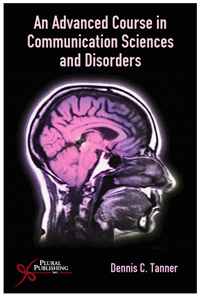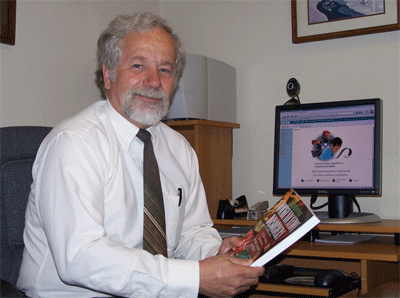Interview with Dennis C. Tanner, Ph.D., Professor & Author
Author of "An Advanced Course in Communication Sciences and Disorders"Plural Publishing ISBN 1-59756-003-0www.pluralpublishing.comBeck:Good Morning Dr. Tanner, thanks for joining me today.Tanner::Good Morning Dr. Beck, it's a pleasure to talk to you.Beck:Before we get to the book, I wonder if you wo
 Author of "An Advanced Course in Communication Sciences and Disorders"
Author of "An Advanced Course in Communication Sciences and Disorders"Plural Publishing
ISBN 1-59756-003-0
www.pluralpublishing.com
Beck:Good Morning Dr. Tanner, thanks for joining me today.
Tanner::Good Morning Dr. Beck, it's a pleasure to talk to you.
Beck:Before we get to the book, I wonder if you would tell me a little about your professional education and background?
Tanner::Sure. I earned my BS degree in communications and my master's degree in speech pathology and audiology from Idaho State University. I earned my doctorate in audiology and speech sciences from Michigan State University in 1976. I had the honor of working with Dr. Oscar Tosi, a physicist and speech scientist, at Michigan State. From that time forward, I've been at Northern Arizona University, here in Flagstaff, and next year will be my 30th year at NAU.
Beck:Dennis, your book was a joy to read. After being in practice for more than 20 years, it was great to read a book that offers a unifying theory to explain what's what and how communication sciences and disorders have a common thread which ties them all together. In essence, I'm tempted to say your book is more about philosophy, than a particular topic within communication sciences. Is that correct?

Tanner:: Yes, that's a reasonable way to describe it. The book has a lot of audiology and speech sciences in it, but it addresses philosophical questions and attempts to answers them. And as you mentioned, it provides a framework from which one can see all of the relationships within communication sciences and disorders, which is the Unified Model. I must admit, I borrowed the title "Unified" from theoretical physics.
Beck:Yes, I'm familiar with it! Nonetheless, your model is comprehensive regarding communication sciences and disorders. Please describe the essence of The Unified Model of Communication Sciences and Disorders.
Tanner::Within the theory, I tried to tie together language, thought processes, motor speech planning, production, and resonance, acoustic transmission of sound, as well as hearing, perception, and auditory association, and then relate disorders to the same processes. Of course, many people have theories about how these processes work together. The Unified Model of Communication Sciences and Disorders admittedly borrows thoughts and concepts from previous authors and their insights, but hopefully, it contributes a little more to the overall discussion.
Beck:You have a quote from Voltaire in the book, "Originality is nothing but judicious imitation." And Einstein said something along the lines of "If I have seen further it's because I stood on the shoulders of giants." So, you're in good company!
Tanner::Thanks Doug.
Beck:OK, let's address some specific issues. Would you please comment on how language impacts cognition?
Tanner::Certainly. Verbal communication cannot exist without thought and language. I read a book in the 1980s by Julian Jaynes, titled "The Origin of Consciousness and the Breakdown of the Bicameral Mind." In that book, Jaynes hypothesized human consciousness is really an evolving product of learning and a property of matter, and our consciousness occurs, in part, due to the role language plays in allowing us to represent ourselves symbolically. Additionally, many people believe that language determines reality. The Whorfian Hypothesis states that words and the structure of a language impact and determine how a speaker of that particular language thinks, and of course, there are pro and con arguments about the hypothesis.
Beck:For example, the old story about Eskimos having 17 words for "snow" versus people in Mexico having one word, despite each of them essentially sharing a common physical experience if and when they experience snow. And that gets to the issues of believing versus knowing, would you address that, please?
Tanner::Yes -- those are basic and important issues and are the foundation to the Unified Model. There are more scientists living in the world today than have ever lived throughout the history of the world. Consequently, many of our "tried and true" beliefs are falling away as they're subjected to scientific scrutiny. So in terms of science and believing, there's not yet enough outcomes-based science to really know what's what, and so we often rely on believing, more than knowing.
Beck:And I guess believing and knowing are not mutually exclusive'?
Tanner::They are not. There are shades of grey and areas of overlap, too.
As professionals, we need to move toward and embrace the research-based "knowing" end of the spectrum, and move further away from "believing." For example, in medicine, physicians cannot prescribe medicines based on belief. The FDA mandates that they wade through clinical trials and research-based outcomes to decide that pill A is useful for diagnosis B, and they prescribe based on "knowing." They use empirical evidence to support their claims and results, and they prove the treatment is valid. In speech and hearing sciences, we have been historically weak on evidence-based research. Nonetheless, this is changing and we're seeing improvements all the time.
Beck:In other words, as professionals, we have often made educated guesses or assumptions, which are considerably less well-founded than scientific arguments and logic based on deductive reasoning?
Tanner::Yes, that's the more global issue and it's often the basis of the core belief held about current diagnostic and treatment theories.
Beck:Would you review those two thought processes for me?
Tanner::Sure. Inductive reasoning, the basis to the scientific method, deals with probabilities such as: Most observed cats are brown. Joey is a cat. Therefore, Joey is brown. The argument does not guarantee that Joey is brown, but provides a probable inference. Deductive reasoning, on the other hand, would state something like: All cats are brown. Joey is a cat. Therefore, Joey is brown. In this argument, if the premise is true and the logical structure valid, then the conclusion is true and valid. It is another way, admittedly less robust than the scientific method, of reasoning. In Communication Sciences and Disorders, we have often depended on informal assumptions rather than science and logical reasoning to support our conclusions and that has led to some "truths" which may have weak or erroneous foundations. ASHA is currently promoting evidenced-based outcomes, and I believe that is an excellent step in the right direction to overcome this shortcoming.
Beck:Agreed. I know other professions and professional societies are taking the same stance and I think this is highly beneficial for the professionals, the societies, and most importantly -- for the patients. Please tell me about "localization" and how it relates to the Unified Model of Communication Sciences and Disorders?
Tanner::The brain localization movement, that specific neuronal tracts and masses of brain cells can be identified and mapped for all communication functions, states that patients with a particular communication disorder have the same or similar neurological deficits. Localization is more valid for motor and sensory-based deficits than for other aspects of communication. However, when we try to localize and describe language-based problems, it has far less, and sometimes, no validity. Cognition and thought processes occur throughout the cerebrum, and therefore, communication disorders like Broca's and Wernicke's Aphasia likely have more real estate involved than we typically correlate with those diagnostic labels. In other words, attempting to localize expressive or receptive language and their disorders to a unique and precise neurologic location is not scientifically sound. I address this in detail in the book (page 223) under the section titled: "The Myth of Wernicke's Area as the Center of Language Understanding" and I have written an article on this topic, which will be published sometime later in 2006, in the Journal of Allied Health.
Beck:Dennis, please tell me about clinical syllogisms?
Tanner::Clinical syllogisms are used to evaluate the integrity and robustness of diagnostic and therapeutic methods and procedures in the absence of hard scientific facts. There are three clinical syllogisms for justifying clinical utility; intuition, authority, and relative application, and the process is based on deductive reasoning.
Clinical intuition is knowing something instinctively based on the clinician's own experience and automatic reasoning. Many clinicians provide much of their services based in the concept of intuition. Clinical authority has to do with a luminary in the profession advocating a particular diagnostic or therapeutic method or procedure or perhaps a professor who speaks as if XYZ is known to him or her to be true, and so everyone accepts that as a clinical fact. The power of clinical authority as a reasoned diagnostic or therapeutic approach is based on the credibility of the authority. In my opinion, the most powerful clinical syllogism that can be used in the absence of scientifically demonstrated clinical procedures is relative application. In relative application, the speech and hearing professional selects a particular procedure because its value has been shown with similar cases; it is borrowed from another clinical situation, profession, or circumstance. For example, treatment methods and procedures for TBI patients used by occupational therapists and neuropsychologists are borrowed and applied to communication disordered patients with TBI. The logical anticipation is that this, too, will have a successful outcome, as it did in the similar situation by other professionals. In the book, I detail the premises, conclusions, and logical structures for each clinical syllogism in Chapter 4.
Beck:Dennis, thanks so much for your time. It was an absolute delight reading your book, and I have totally enjoyed speaking with you.
Tanner::Thanks Doug. I appreciate your time, too.
